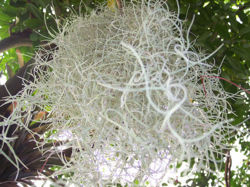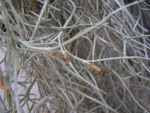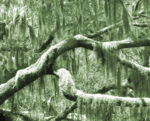Spanish moss
| Spanish moss |
|---|

|
| Scientific Classification |
|
| Binomial Name |
|
Tillandsia usneoides |
Spanish Moss is a species of epiphytes (a plant that lives upon other plants). It is also commonly known as the "air plant" and was referred to as "tree hair" by native Americans. Despite its name, it is not a moss, but a flowering plant, closely related to the pineapple.
Anatomy
The Spanish Moss is referred to as an air plant because most moss have aerial roots, but the Spanish Moss doesn't have any roots. The Spanish Moss uses its long thin scaly stems to wrap around the host tree. The Spanish Moss has leaves that are covered with cup-like, permeable scales that catch the moisture and nutrients that are in the air. With this ability of water-trapping, allows the Spanish moss to withstand long dry periods.
The Spanish Moss may not be parasitic, but it can still damage the host tree by over-shading the leaves, which reduces photosynthesis, and it can weigh down the branches, which breaks them.
SIZE/FORM
The Spanish Moss hangs from trees in thick masses that will reach about 20'.
LEAVES
The Spanish Mosses leaves are a grayish-green, and grow to about 2" long.
FLOWERS
The Spanish Moss has tiny flowers that bloom a pale greenish-blue color. The flowers bloom in the middle of the leaves and give off a light fragrance at night.
FRUIT
After the flowers are gone tiny capsules will develop and will eventually split open to release the seeds.
HABITAT
The Spanish Moss likes partial shaded areas, and it prefers moist environments but can survive in dry areas. Spanish Moss clings more to Oak or Cypress trees, but it can be found on many other species. [1]
Reproduction
The Spanish Moss has small seeds that get carried away by the wind and or birds. Birds will carry small fragments that will easily reproduce new plants. The birds will use strands of the moss to build their nest, which help distribute the festoons. When the leaves of the tree drop in the winter and fall, some fragments of the moss will attach themselves to the bark. Even when there is no more moss, just a little bit will grow and become a whole bunch of moss, covering all the branches in the tree.
Ecology
The Spanish Moss an air-feeding plant that is found on mainly Cypress, Gum trees, Oaks, Elms, and Pecan trees. The Spanish Moss does not live on the ground, it only lives on trees. This moss grows in the extreme southern part of Virginia, the Gulf Coast, Florida, and Texas. The Spanish Moss will only grow on trees, and will not grow on vines or wooden fences. [2]
These are some of the places that the Spanish moss grows; Fairhope, Alabama Canoga Park, California Hayward, California Reseda, California Spring Valley, California Bartow, Florida Big Pine Key, Florida Boca Raton, Florida Bradley, Florida Deland, Florida Deltona, Florida Fort Lauderdale, Florida Fountain, Florida Hollywood, Florida Homosassa, Florida Jacksonville, Florida (2 reports) Lake City, Florida Lutz, Florida New Port Richey, Florida Ocoee, Florida Parrish, Florida Pompano Beach, Florida Port Saint Lucie, Florida Sarasota, Florida Tallahassee, Florida West Palm Beach, Florida Honomu, Hawaii Kailua, Hawaii Kailua Kona, Hawaii Moss Point, Mississippi Natchez, Mississippi Ocean Springs, Mississippi Cincinnati, Ohio Conway, South Carolina Saint Helena Island, South Carolina Summerville, South Carolina (2 reports) Broaddus, Texas San Antonio, Texas [3]
Uses
Many Native American tribes used the Spanish Moss for bedding, floor mats, and horse blankets. The fibers could also be made into rope. The Native Americans used the ropes to hold the poles together that were the framework of the house.
The Spanish Moss was also used for fire arrows. To create this, the Native Americans would put a bundle of green moss into a pond for six weeks until the outer layer roted off, then it was set out to dry. To make the fire arrows, the moss would be wrapped around the shaft of the arrow and then lit.
The Spanish moss was used for so many different things like a game, plastering the inside of houses, and also to keep canoes from drying out and splitting. [4]



